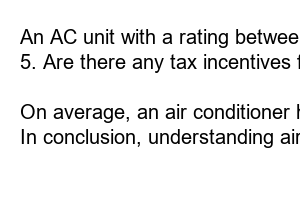에어컨 평수 계산
Air Conditioner Rating Calculation: Everything You Need to Know
When it comes to buying an air conditioner, the rating is one of the most crucial factors to consider. An air conditioner’s rating tells you how efficient it is and how much electricity it consumes. So, understanding air conditioner rating calculation is essential when purchasing a new one. In this article, we’ll break down the AC rating and explain how it’s calculated.
1. What is an Air Conditioner Rating?
The air conditioner rating is a measure of the effectiveness of the AC unit in cooling the room. It helps you know how well an air conditioner operates at a specific set of conditions. The higher the rating, the more energy-efficient the AC unit is.
2. SEER Rating
The most common rating used to measure the efficiency of air conditioning systems is SEER, or Seasonal Energy Efficiency Ratio. The SEER rating is calculated by dividing the air conditioner’s cooling output with the amount of energy it uses during a season. The more cooling output it produces with less energy consumption, the higher the SEER rating.
3. EER Rating
Another rating used is the EER, or Energy Efficiency Ratio. This rating is calculated by dividing the air conditioner’s cooling capacity by the power it consumes. The higher the EER rating, the more efficient the AC unit.
4. BTU Rating
The British Thermal Unit or BTU is another rating used to measure the cooling power of an AC unit. The BTU rating tells you the amount of heat an air conditioner can remove from a room per hour. The higher the BTU rating, the more cooling power the air conditioner has.
5. How to Calculate the AC Rating?
To calculate the rating of an air conditioner, you need to identify its SEER, EER, and BTU ratings. You can find these ratings on the product label or specifications provided by the manufacturer. Then, use the following formula to calculate the rating:
SEER Rating x EER Rating ÷ 10,000 = AC Rating
or
BTU Rating ÷ 12,000 = AC Rating
6. Importance of Understanding the AC Rating
Understanding the AC rating is essential when buying an air conditioning unit. Knowing the rating will help determine the efficacy of the unit and how much electricity it consumes. A higher rating AC unit may cost more to purchase, but it will provide you with significant savings in energy costs in the long run.
FAQ’S
1. What does a higher SEER rating mean?
A higher SEER rating means the air conditioner is more energy-efficient and can operate with less energy cost.
2. What’s the difference between SEER and EER?
SEER measures an AC unit’s efficiency over a year, while EER measures its efficiency at a specific moment.
3. What is the ideal BTU rating for my room size?
To determine the ideal BTU rating for your room size, calculate the area of your space in square feet and find an AC unit with a corresponding BTU rating.
4. What’s a good AC rating to look for?
An AC unit with a rating between 14 and 22 is considered good.
5. Are there any tax incentives for purchasing an energy-efficient AC unit?
Many states and utility companies offer tax incentives or rebates for purchasing energy-efficient AC units.
6. How often should I replace my air conditioner?
On average, an air conditioner has a lifespan of 10 to 15 years, depending on how well it’s maintained. However, if it’s not operating efficiently or requires frequent repairs, consider replacing it.
In conclusion, understanding air conditioner rating calculation is crucial when buying an AC unit. Knowing the SEER, EER, and BTU ratings can help you make an informed decision on which unit to purchase. Don’t forget to compare prices, read reviews, and check the manufacturer’s warranty before making a final decision.

